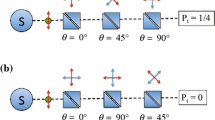Abstract
Measures and theories of information abound, but there are few formalised methods for treating the contextuality that can manifest in different information systems. Quantum theory provides one possible formalism for treating information in context. This paper introduces a quantum inspired model of the human mental lexicon. This model is currently being experimentally investigated and we present a preliminary set of pilot data suggesting that concept combinations can indeed behave non-separably.



Similar content being viewed by others
Notes
Full results are available at http://www.quantum-interaction.org/conceptCombinationExpts/data together with the analysis files. Use the login/password pair data/data to view the files.
References
Ballentine L (1998) Quantum mechanics: a modern development. World Scientific, Singapore
Bruza P, Kitto K, Nelson D, McEvoy C (2009) Is there something quantum-like about the human mental lexicon?. J Math Psychol 53:362–377
Clauser JF, Horne MA (1974) Experimental consequences of objective local theories. Phys Rev D 10(2):526–535
Collins AM, Loftus EF (1975) A spreading-activation theory of semantic processing. Psychol Rev 82(6):407–428
Gärdenfors P (2000) Conceptual spaces: the geometry of thought. MIT Press, Cambridge, MA
Grangier P (2003) Contextual objectivity and quantum holism. arXiv:quant-ph/0301001v2, 2003
Isham CJ (1995) Lectures on quantum theory. Imperial College Press, London
Kitto K (2008) High end complexity. Int J Gen Syst 37(6):689–714
Kitto K (2009) Science and subjectivity. Literary Paritantra (Syst) 1(3,4):18–28
Kitto K, Bruza P. Modelling ‘high end complexity’ using the quantum formalism (under review)
Kitto K, Ramm B, Bruza PD, Sitbon L (2010) Testing for the non-separability of bi-ambiguous words. In: Proceedings of the AAAI fall symposium on quantum informatics for cognitive, social, and semantic processes (QI 2010), AAAI Press
Laloë F (2001) Do we really understand quantum mechanics? Strange correlations, paradoxes, and theorems. Am J Phys 69(6):655–701
Losee RM (1990) The science of information. Library and Information Science. Academic Press, New York
Mermin ND (1993) Hidden variables and the two theorems of John Bell. Rev Mod Phys 65(3):803–815
Nelson D, McEvoy C, Pointer L (2003) Spreading activation or spooky action at a distance? J Exp Psychol: Learn Mem Cogn 29(1):42–52
Nelson D, McEvoy C, Schreiber T (2004) The University of South Florida, word association, rhyme and word fragment norms. Behav Res Method Instrum Comput 36:408–420
Nelson DL, McEvoy CL (2007) Entangled associative structures and context. Stanford University, AAAI Press
Nelson DL, Schreiber TA, McEvoy CL (1992) Processing implicit and explicit representations. Psychol Rev 99(2):322–348
Shannon CE (1948) A mathematical theory of communication. Bell Syst Tech J 27:379–423
Van Rijsbergen C (2004) The geometry of information retrieval. Cambridge University Press, UK
Widdows D (2004) Geometry and meaning. CSLI Publications, Stanford
Acknowledgments
This work was supported by an Australian Research Council (ARC) Post Doctoral Fellowship (project number DP1094974), and by ARC Discovery Project DP0773341.
Author information
Authors and Affiliations
Corresponding author
Rights and permissions
About this article
Cite this article
Kitto, K., Ramm, B., Sitbon, L. et al. Quantum Theory Beyond the Physical: Information in Context. Axiomathes 21, 331–345 (2011). https://doi.org/10.1007/s10516-010-9144-6
Received:
Accepted:
Published:
Issue Date:
DOI: https://doi.org/10.1007/s10516-010-9144-6




